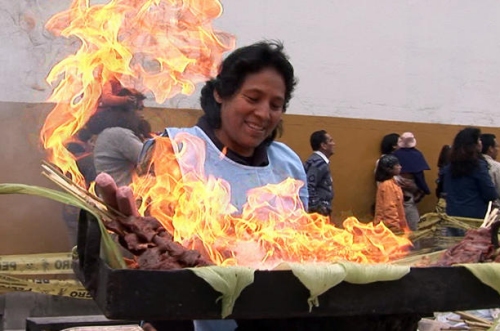Peruvian cuisine has designs on the world March 25, 2011
Mele Pesti on „Cooking Up Dreams“
Worldfilm organisers promised this year to put an accent of the festival on different senses. The sense of taste has actually always been greatly respected on this festival: the best delicacies of Estonian cooking are offered both to foreign visitors and to film viewers – and so it was also this year, when at the opening evening, the whole hallful of spectators could enjoy a wonderful potato porridge.
The Peruvian film has taken itself a task to stimulate our sense of taste as intensely as it can ever be done on the cinema screen. „Cooking Up Dreams“ is so full of visual culinary temptations, that already the short trailer makes you understand that to come and see this film with an empty stomach would be a pure self torture.

On the first look, the idea given out in the beginning of the film to develop the Peruvian cuisine into a famous conception like a sushi-restoran, seemed a bit too ambitious. Just an hour later, it appeared completely possible. All the chefs, chef students and food connoisseurs interviewed in the film agreed on one point: in Peru, the food is delicious and quite unique, and it would be only a matter of initiative to take this knowledge to the world. And the film that we just saw makes a step forward in that, with its quickly moving image and slightly TV-like editing, which may even make it look slightly like an advert movie.
The film crew travelled throughout the world and showed different stories of success of the Peruvian restaurants in London, Paris, New York... In the mean while, the images of Peruvian cooking took the viewer to the Peru country side, as well as city streets, where in huge pots are mixed together the wonderful tastes, which the Peruvians living out in the world miss and look for, to take them back to their childhood. One of the most exciting ways of cooking started off by building a pyramid out of cobbles, under which was made a fire, the stones were made hot, and the pieces of raw meat, potatoes and peapods were put in-between them. Then the pyramid was made to collapse and covered carefully. In about 45 minutes, the underground oven had done its job. The stones were dug open and a perfectly cooked and apparently delicious meal was picked up.
I haven't travelled to Peru yet, myself, but I suppose that their neighbouring country Bolivia has many similar tastes. I remember my astonishment when on a barren-looking landscape in an isolated mountain village on Bolivian plateau, the lady of the house offered us incredible fresh meat and fish dishes, vegetable stews and soups, into which a lot ot coca leaves were added, to make it easier to bear the hight. (And the price for it all was, at the time, about 0.4 € for two.) In Peru, the Amazonian tastes are added, like fish who eat lots of exotic fruits during the high water period. In Madrid food festival, it was precisely with those fish that the Peruvian chefs managed to amaze and seduce the jury.
Peruvians are generally not materially
very rich, in our terms. Keeping that in mind, it may seem strange,
in a film about Peruvian cuisine, to see many beautifully set gourmet
dishes and extra fine restaurants. However, I didn't feel a great
contrast between that side and the village food. On the other hand,
the contrast between rich and poor is high and it is a burning issue,
as one of the best chefs points it out in the film. It is still
difficult to give solutions and they didn't find any in the film, and
the distant plan to improve the homeland's situation by advertising
Peruvian food in Europe's fancy restaurants to invite more tourists
to Peru, didn't seem very convincing. But there was a much stronger
metaphor in the images showing a parallel between a moving crowd of
people and a potful of vegetables becoming a united mass of a puree.
„Why can't we mix our differences here in this country, and become
stronger through that, in the same way that we mix tastes in the
cooking?“ asks the narrator. One of the protagonists remembers that
in his childhood, being a mestizo was still pejorative, but now he is
very proud of his identity. So the situation is getting better, and
if the Peruvian cooking has a role to play in it, then we can only
hope that a Peruvian chef will find his way to Estonia, as well.
Mele Pesti, PhD student of culture studies